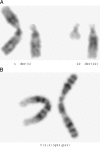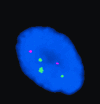Molecular cytogenetic characterization of tenosynovial giant cell tumors
- PMID: 15548367
- PMCID: PMC1531662
- DOI: 10.1593/neo.04202
Molecular cytogenetic characterization of tenosynovial giant cell tumors
Abstract
Tenosynovial giant cell tumor (TSGCT) is a disease of disputed etiology and pathogenesis. Some investigations indicate a neoplastic origin of the tumors; others indicate that they are polyclonal and inflammatory. The cytogenetic and molecular genetic features of TSGCTs are largely unknown, as only some 20 localized and 30 diffuse tumors with cytogenetic aberrations have been reported. The most common karyotypic aberrations have been trisomy for chromosomes 5 and 7 and translocations involving chromosomal area 1p11-13. We decided to screen the genomes of TSGCTs by comparative genomic hybridization (CGH) to perform interphase fluorescence in situ hybridization (IP-FISH), looking for numerical aberrations of chromosomes 1, 5, and 7, and to analyze the tumors for microsatellite instability. Except for two diffuse TSGCTs that came fresh to us, and which, by karyotyping, exhibited t(1;22)(p13;q12) and a t(1;1)(q21;p11) and +7, respectively, all studies had to be performed on formalin-fixed, paraffin-embedded material. DNA was extracted from 51 localized and nine diffuse TSGCTs. CGH was successful for 24 tumors, but none of them showed copy number changes. The IP-FISH studies showed trisomy 7 in 56% of the tumors (15/27), whereas chromosomes 1 and 5 seemed to be disomic in all TSGCTs. All informative tumors were wild-type by microsatellite instability analysis.
Figures


Similar articles
-
Analysis of 35 cases of localized and diffuse tenosynovial giant cell tumor: a report from the Chromosomes and Morphology (CHAMP) study group.Mod Pathol. 1999 Jun;12(6):576-9. Mod Pathol. 1999. PMID: 10392632
-
Immunohistochemical and biogenetic features of diffuse-type tenosynovial giant cell tumors: the potential roles of cyclin A, P53, and deletion of 15q in sarcomatous transformation.Clin Cancer Res. 2008 Oct 1;14(19):6023-32. doi: 10.1158/1078-0432.CCR-08-0252. Clin Cancer Res. 2008. PMID: 18829481
-
Cytogenetic characterization of tenosynovial giant cell tumors (nodular tenosynovitis).Cancer Res. 1994 Aug 1;54(15):3986-7. Cancer Res. 1994. PMID: 8033128 Review.
-
Diffuse-type tenosynovial giant cell tumor with t(1;17)(p13;p13) and trisomy 5.In Vivo. 2014 Sep-Oct;28(5):949-52. In Vivo. 2014. PMID: 25189912
-
A new cytogenetic subgroup in tenosynovial giant cell tumors (nodular tenosynovitis) is characterized by involvement of 16q24.Cancer Genet Cytogenet. 1996 Mar;87(1):85-7. doi: 10.1016/0165-4608(95)00244-8. Cancer Genet Cytogenet. 1996. PMID: 8646750 Review.
Cited by
-
A review of the past, present, and future directions of neoplasia.Neoplasia. 2005 Dec;7(12):1039-46. doi: 10.1593/neo.05793. Neoplasia. 2005. PMID: 16354585 Free PMC article. Review. No abstract available.
-
Fine needle aspiration cytology diagnosis of metastatic malignant diffuse type tenosynovial giant cell tumor.J Cytol. 2017 Jul-Sep;34(3):174-176. doi: 10.4103/0970-9371.208111. J Cytol. 2017. PMID: 28701836 Free PMC article.
-
Updates on the cytogenetics and molecular cytogenetics of benign and intermediate soft tissue tumors.Oncol Lett. 2013 Jan;5(1):12-18. doi: 10.3892/ol.2012.1002. Epub 2012 Oct 30. Oncol Lett. 2013. PMID: 23255885 Free PMC article.
-
Giant cell tumour of EHL tendon sheath in young: a rare case report and review of the literature.BMJ Case Rep. 2021 Sep 20;14(9):e242980. doi: 10.1136/bcr-2021-242980. BMJ Case Rep. 2021. PMID: 34544702 Free PMC article. Review.
-
Tumor spreading to the contralateral ovary in bilateral ovarian carcinoma is a late event in clonal evolution.J Oncol. 2010;2010:646340. doi: 10.1155/2010/646340. Epub 2009 Sep 15. J Oncol. 2010. PMID: 19759843 Free PMC article.
References
-
- Sciot R, Rosai J, Dal Cin P, De WI, Fletcher CD, Mandahl N, Mertens F, Mitelman F, Rydholm A, Tallini G, den Van BH, Vanni R, Willen H. Analysis of 35 cases of localized and diffuse tenosynovial giant cell tumor: a report from the Chromosomes and Morphology (CHAMP) study group. Mod Pathol. 1999;12:576–579. - PubMed
-
- Weiss SW, Goldblum JR. Enzinger and Weiss's Soft Tissue Tumors. 4th ed. St. Louis: Mosby; 2001.
-
- Jaffe HL, Lichtenstein L, Sutro CJ. Pigmented villonodular synovitis, bursitis and tenosynovitis. A discussion of the synovial and bursal equivalents of the tenosynovial lesion commonly denoted as xanthoma, xanthogranuloma, giant cell tumor or myeloplaxoma of the tendon sheath, with some consideration of this tendon sheath lesion itself. Arch Pathol. 1941;31:731–764.
-
- Somerhausen NS, Dal Cin P. WHO classification of tumours. Pathology and genetics of tumours of soft tissue and bone. In: Fletcher KK, Unni KK, Mertens F, editors. So-Called Fibrohistiocytic Tumours. Lyon: IARC; 2002. pp. 110–114.
-
- Kempson RL, Fletcher CDM, Evans HL, Hendrickson MR, Sibley RK. Atlas of Tumor Pathology. Bethesda: Tumors of the Soft Tissues Armed Forces Institute of Pathology; 2001.
Publication types
MeSH terms
LinkOut - more resources
Full Text Sources
